A celebration of the “Santo Niño” (or Holy Child Jesus), a symbol of the birth of Catholicism in the Philippines more than 500 years ago, took place on Jan. 19, 2025, at Incarnation Parish in Sarasota.
The Diocese of Venice Santo Niño Festival on the Second Sunday of Ordinary Time was organized by the local Filipino Catholic Community (Senor Santo Niño Devotees of Manasota Florida, Inc.), with more than 600 people participating in the Mass and Festival which celebrates an important conversion story. This was the fourth year for this Festival in the Diocese.
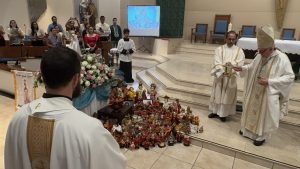
Bishop Frank J. Dewane was the main celebrant for the Mass and said the Santo Niño Mass and Festival “is a wonderful example of a faith and culture coming together beautifully and this devotion has spread throughout the world due to the spreading of Philippine culture into the world. You hear the call of Santo Niño to help fulfill your mission in life to serve the Lord, and you answer the call.”
Bishop Dewane encouraged everyone to gain strength from the celebration and use that spirit going forward to recommit themselves to the presence of the Lord in their life.
“It is a challenge because we are human. We are going to fail,” Bishop Dewane said. “However, the Lord gives us the grace to build upon our nature and grow closer to Him.”
The celebration is an opportunity to refocus on the children in the Filipino Catholic community.
“During this Eucharistic celebration let us entrust our children to the protection and guidance of the Holy Child, as He is so much a part of history and our lives,” said a leader of the Senor Santo Niño Devotees of Manasota Florida, Inc. “We ask Santo Niño to take care of our children and teach us how to do likewise.”
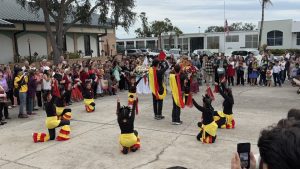
The Feast Day celebration serves to remind Filipinos of the Christianization of their homeland in the 16th century but also enables them to see the relevance that this devotion to the Santo Niño has for people to this day, whether they are living in the Philippines or elsewhere. The Feast places a special emphasis on the children and youth, with all the hopes they raise.
The Mass opened with the traditional presentation of the Santo Niño statue to Bishop Dewane. In addition, the faithful are encouraged to bring their own Santo Niño statue, or one purchased in the past year, to be blessed. This was also done at the conclusion of the Mass.
This builds upon the tradition of Filipino immigrants who brought their Santo Niño statues with them to the United States to be their spiritual recourse, assistant and protector.
Following the Mass, the celebration continued with traditional music and dancers first outside the Parish and then in the Parish Hall.





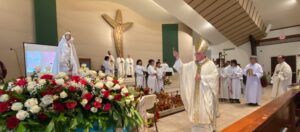
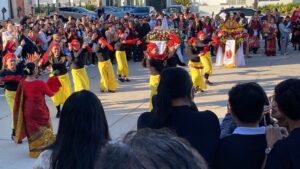
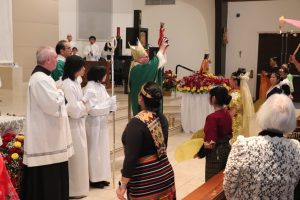 Incarnation Parish in Sarasota was host to the Diocese of Venice Santo Niño Festival on Jan. 15, 2023, the Second Sunday of Ordinary Time. Organized by the local Filipino Catholic Community and the Couples for Christ group, more than 250 people participated in the Mass and Festival which recounts an important conversion story. This was the second year for this festival in the Diocese.
Incarnation Parish in Sarasota was host to the Diocese of Venice Santo Niño Festival on Jan. 15, 2023, the Second Sunday of Ordinary Time. Organized by the local Filipino Catholic Community and the Couples for Christ group, more than 250 people participated in the Mass and Festival which recounts an important conversion story. This was the second year for this festival in the Diocese.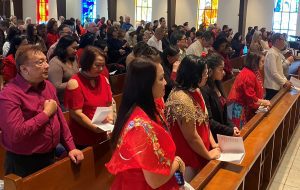 Conflict in the region soon followed during which Magellan was killed and his Spanish colleagues left. The next Spanish expedition occurred in 1565 by Miguel Lopez de Legazpi who conquered Cebu and after pillaging the villages, the original Magellan Santo Niño was found safe and unscathed from the fires. The Franciscan Friars who witnessed this proclaimed the statue miraculous and built a church on the site, which is now the “Basílica Menor del Santo Niño in Cebu.”
Conflict in the region soon followed during which Magellan was killed and his Spanish colleagues left. The next Spanish expedition occurred in 1565 by Miguel Lopez de Legazpi who conquered Cebu and after pillaging the villages, the original Magellan Santo Niño was found safe and unscathed from the fires. The Franciscan Friars who witnessed this proclaimed the statue miraculous and built a church on the site, which is now the “Basílica Menor del Santo Niño in Cebu.”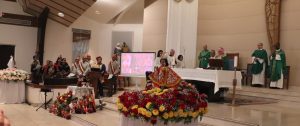 The Santo Niño celebration calls us to go forward as individuals to behold the Holy Child, the Incarnation of Jesus Christ who was there to save the world, the Bishop added.
The Santo Niño celebration calls us to go forward as individuals to behold the Holy Child, the Incarnation of Jesus Christ who was there to save the world, the Bishop added.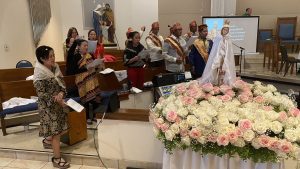 The Feast Day celebration reminds Filipinos of the Christianization of their homeland but also enables them to see the relevance this devotion to the Santo Niño has for people to this day. It places a special emphasis on the children and youth, with all the hopes they raise.
The Feast Day celebration reminds Filipinos of the Christianization of their homeland but also enables them to see the relevance this devotion to the Santo Niño has for people to this day. It places a special emphasis on the children and youth, with all the hopes they raise.